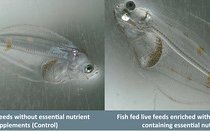UNITED STATES - Researchers at Oregon State University are developing a new technology to deliver water-soluble nutrients to aquaculture-raised fish, oysters, clams and shrimp that will boost their growth rates and reduce the high rates of mortality that plague the industry.
As much as 80 percent of hatchery-reared larval marine fish die in their early life stages and researchers aren’t exactly sure why, according to Chris Langdon, a professor of fisheries at OSU’s Hatfield Marine Science Center and principal investigator on the project. One prevailing theory, he said, is that the critical water-soluble vitamins and amino acids rapidly leach from their tiny food pellets into the water.
“We’re having some success by packaging water-soluble nutrients into liposomes that we use to enrich the live feeds – for example, brine shrimp – or put inside of food pellets,” Langdon said. “The next step is to expand the project and look at how it affects different fish species, and whether we can make it cost-effective.”
Langdon and his colleagues have received a three-year, $630,000 grant from the National Sea Grant program to conduct further tests. The study is important, scientists say, because the United States has a major seafood deficit, importing more than $11 billion of seafood products annually from other countries.
Aquaculture will be critical in the future to produce protein for the world’s growing population because many wild stocks of fish have already reached their peak levels of sustainable harvest, Langdon noted. However, most marine fish hatcheries are not efficient models of production, he added.
“If we can halve that mortality rate – and I think we can – it would be a game-changer,” Langdon said.
The key to the preliminary success by the OSU scientists, which include post-doctoral researcher Matt Hawkyard, lies in production of liposomes, which are tiny vesicles, or bubbles, made out of the same material as a cell membrane. These liposomes are very efficient in containing nutrients – and other products – despite their small size.
For example, the pellets used to feed larval aquatic animals are often smaller than a grain of sand, making them difficult to enrich. Over the past 5-6 years, however, OSU researchers have done just that, by incorporating liposomes that are filled with nutrients. They also use those same liposomes to boost the nutrient power of live feeds, such as tiny “rotifers,” which are planktonic organisms that larval fish consume.
That may just be the beginning, Langdon said.
“We also can fill the liposomes with other substances, such as growth-promoting agents, vaccines, or vitamins to boost the animals’ immune systems and reduce stress,” he said. “In addition to aquaculture for food species, there is a potentially huge opportunity to improve the survival and health of ornamental fish for the aquarium industry that is worth billions of dollars.”
Langdon and Hawkyard are working with the Hubbs-SeaWorld Research Institute in San Diego to broaden the scope of their study, focusing on improving growth rates and reducing losses in California yellowtail, sea bass and ornamental fish.
OSU's Hatfield Marine Science Center is a research and teaching facility located in Newport, Ore., on the Yaquina Bay estuary, about one mile from the open waters of the Pacific Ocean. It plays an integral role in programs of marine and estuarine research and instruction, as a laboratory serving resident scientists, as a base for far-ranging oceanographic studies and as a classroom for students.











